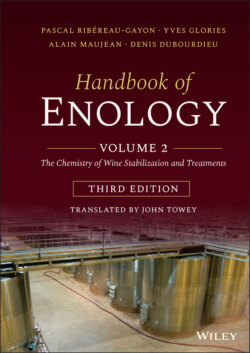Читать книгу Handbook of Enology, Volume 2 - Pascal Ribéreau-Gayon - Страница 59
2.5 Esters
ОглавлениеEsters are formed when an alcohol function reacts with an acid function and a water molecule is eliminated (Figure 2.7). It is a reversible reaction, limited by the reverse reaction of hydrolysis of the ester. When the system is in equilibrium, there is a constant ratio between the concentrations of the substances present, governed by the law of mass action.
There are a large number of different alcohols and acids in wine, so the number of possible esters is also very large. Ethyl esters are the most common for kinetic reasons, i.e. owing to the large quantities of ethanol present and the fact that primary alcohols are the most reactive.
Very few esters are present in grapes. Some contribute to aroma, such as methyl anthranilate, which is responsible for the foxy odor in Vitis labrusca grapes and wines made from them. There are also methoxy groups in pectins that release methanol by hydrolysis (Section 2.2.1).
FIGURE 2.7 Esterification equilibrium of an alcohol.
Esters in wine have two distinct origins: enzymatic esterification during the fermentation process and chemical esterification during long‐term aging. The same esters may be synthesized in either way.
